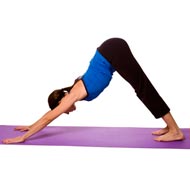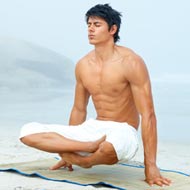- Sun Salutation
- Headstand
- Inverted Triangle Pose
- Hand to Foot Pose
- Lion Pose
- Head to One Knee Pose
- Head to Knees Pose
- Camel Pose
- Sage Marichi Twist Pose
- Half Lord of the Fish Pose
- Inverted Leg Stretch Pose
- Shoulder Stand
- Plough Pose
- Inclined Plane
- Boat Pose
- Fish Pose
- Wheel Pose
- Bridge Pose
- Cobra Pose
- Bow Pose
- Locust Pose
- Eagle Pose
- Peacock Pose
- Crow Pose
- Corpse Pose
- Yoga Balance Asanas
- Yoga Asanas For Spine
- Yoga Asanas in Chair
- Basic Yoga Asanas For Stomach
- Yoga Asanas For The Neck
- Yoga Asanas For Depressed
- Yoga Asanas For Beginners
- Sequencing Yoga Asanas
- One Legged King Pigeon Pose - Eka Pada Rajakapotasana
- Reclining Bound Angle Pose - Supta Baddha Konasana
- Eight Angle Pose - Astavakrasana
- Hand Clenching
- Side Crane Pose - Parsva Bakasana
- Ankle Rotation
- Circle pose - Mandalasana
- Dolphin Plank Pose
- Half Frog Pose - Ardha Bhekasana
- Four-Limbed Staff Pose - Chaturanga Dandasana
- Extended Puppy Pose - Uttana Shishosana
- Supported Headstand - Salamba Sirsasana
- Pendant Pose - Lolasana
- Shoulder-Pressing Pose - Bhujapidasana
- Ankle Bending
- Wrist Bending
- Standing Half Forward Bend
- Side-Reclining Leg Lift
- Standing Yoga Seal
- Shiva Twist
- Upward Salute
- Intense Side Stretch Pose
- Wild Thing
- Great Hand Posture
- Upward Bow
- Warrior Seal
- Spread Leg Forward Fold
- Legs-Up-the-Wall Pose
- King Pigeon Pose
- Arm Pressing Posture
- Upward-Facing Dog
- Crocodile Pose
- Feathered Peacock Pose
- Reclining Angle Pose
- Reclining Hero Pose
- Half Headstand Pose
Downward Facing Dog Pose - Adho Mukha Svanasana
The "Downward Facing Dog" or Adho Mukha Svanasana is most often performed as a part of Surya namaskaras (Sun Salutations).
‘Adho’ in Sanskrit means’ dog’, ‘mukha’ means ‘face and ‘asana’ means ‘pose’.
This inverted pose is performed lengthwise on a mat with the hands and feet pushing against the floor. The hips are raised in the air. The body eventually forms a pyramidal triangular shape. This pose is similar to the position a dog takes while stretching after having a nap.
Downward Facing Dog Pose
The “Downward Facing Dog” can be practiced as a preparatory pose for the standing poses, or to warm-up the muscles before a session of yoga. In many yoga styles this pose is repeated several times during a yoga class. Since the head is brought lower than the pelvis this posture is normally classified as an inversion pose.
Steps
The downward facing dog steps are as follows:
- To start this posture, you should start off on your knees and hands. Keep your knees directly below the hips and your hands a little in front of your shoulders. Let your palms be spread out and your index fingers slightly turned out or parallel.
- Breathe out and raise your knees away from the ground. Initially, you can keep your knees a little bent and your heels raised up from the ground. Then, elongate your tailbone away from your pelvis and press it gently to the pubis. Lift your sitting bones against this resistance toward the ceiling and draw your legs into the groin.
- Then, while breathing out let the top of your thighs be pushed back and your heel stretched against the floor. Your knees should be straight but not locked. Keep your thighs firm and roll the top of your thighs inwards. The front of the pelvis should be kept narrow.
- Brace your arms and press the index fingers bases actively into the ground. From areas of the index finger bases raise yourself. This should be done from the wrists to the shoulder tops. Keep your shoulder blades firm. Then widen them and bring them to the tailbone. Your head should be between your upper arms. Avoid letting it droop.
- “The Downward Facing Dog Pose” is part of the traditional sun salutation series. It is also a very effective pose just by itself. You can stay in this pose for a few minutes. To exit this pose, you should bend your knees to the ground, exhale and come to rest in Balasana (Child Pose).
Precautions
Downward Facing Dog Pose precautions include:
- Avoid this pose if you suffer from carpal tunnel syndrome and diarrhea.
- Avoid practicing this pose during the latter stages of pregnancy.
It is also unadvisable to practice this pose for extended periods during the time of menstruation. - If you have a headache or suffer from high blood pressure, you should support your head with a block or bolster.
- Also avoid this pose if you suffer from a chronic or recent injury to the shoulders, arms, hips and back.
Always consult your doctor if you have any concerns or doubts about how this pose will suit you, and ensure that you learn from a yoga practitioner as this ensures that you learn the posture correctly to avoid injuries.
A Beginner’s tip
A good Beginner’s tip For Downward Facing Dog Pose is to keep your hands off the ground on a couple of blocks or on the seat of a metal chair. Open up your shoulders during the pose.
Benefits to the body
The benefits of the “Downward Facing Dog” include the following:
- Stretches the hands, arches, calves, hamstrings and shoulders.
- Relives, back pain, insomnia and head ache.
- Helps with sciatica, asthma and high blood pressure.
- Lengthens and strengthens the spine.
Therapeutic Applications
Some of the therapeutic applications of the “Downward Facing Dog” include the:
- Helps bring relief to the menopausal symptoms.
- Brings relief to menstrual discomfort when performed with the head supported.
- Helps in the prevention of osteoporosis.
- Improves digestion.
- Helps with sinusitis.
- Therapeutic for flat feet
- Energies the body.
- Relaxes the brain and helps relieve mild depression and stress.
- Reduces fatigue.
Variations
Variations for Downward Facing Dog Pose can be performed if the individual is not able to perform the pose due to physical limitations or injuries. It can also be performed if a person wants to master this pose.
- To feel the working of the arms, you could loop a strap around your arms, above your elbows. Then, push your shoulder blades outward against this resistance.
- To increase the difficulty level in this pose, breathe in and lift your right leg parallel to your torso line and remain in this position for 30 seconds. Keep your hips level and press through the heel. You can release while breathing out and repeat it on the left side for the same duration of time.
Preparatory Poses
Preparatory Poses for Downward Facing Dog Pose includes the following:
- Chaturage Dandasana (Plank pose)
- Uttanasana (Standing Forward Bend)
Follow up poses
Follow up poses for Downward Facing Dog Pose includes the following:
- Balasana (Child Pose)
- Sirsasana (Headstand)
- Standing poses
You can also make use of a partner to help you. First, get in to the Downward Facing Dog Pose. Then, ask your partner to stand behind you and put a strap around the front of your groin. The strap should be snuggled into the crease between your front pelvis and thighs. Your partner should then pull the strap parallel to the spine line. Remind your partner to fully extend the arms, keep the chest lifted and knee bent.



